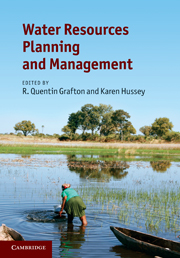Book contents
- Frontmatter
- Contents
- List of contributors
- Foreword
- Preface
- Acknowledgements
- Introduction
- Part I Understanding ‘water’
- Part II Water resources planning and management
- Part III Water resources planning and management: case studies
- III. 1 Water and waste water treatment
- III. 2 Agricultural water use
- III. 3 Urban water supply and management
- III. 4 Aquatic ecosystems
- III. 5 Industrial and mining water use
- III. 6 Rural and remote communities
- 28 Aboriginal access to water in Australia: opportunities and constraints
- 29 Providing for social equity in water markets: the case for an Indigenous reserve in northern Australia
- III. 7 Water infrastructure design and operation
- III. 8 Managing water across borders
- III. 9 Market mechanisms in water management
- Contributors
- Index
- References
29 - Providing for social equity in water markets: the case for an Indigenous reserve in northern Australia
from III. 6 - Rural and remote communities
Published online by Cambridge University Press: 05 August 2011
- Frontmatter
- Contents
- List of contributors
- Foreword
- Preface
- Acknowledgements
- Introduction
- Part I Understanding ‘water’
- Part II Water resources planning and management
- Part III Water resources planning and management: case studies
- III. 1 Water and waste water treatment
- III. 2 Agricultural water use
- III. 3 Urban water supply and management
- III. 4 Aquatic ecosystems
- III. 5 Industrial and mining water use
- III. 6 Rural and remote communities
- 28 Aboriginal access to water in Australia: opportunities and constraints
- 29 Providing for social equity in water markets: the case for an Indigenous reserve in northern Australia
- III. 7 Water infrastructure design and operation
- III. 8 Managing water across borders
- III. 9 Market mechanisms in water management
- Contributors
- Index
- References
Summary
Introduction
Across tropical northern Australia there is a significant Indigenous population which suffers from chronic socio-economic disadvantage. Against a backdrop of federally led national water reform, Indigenous peoples in jurisdictions across the region are seeking to have their social, cultural, and economic aspirations recognised and supported in water-sharing and market frameworks (Lingiari Foundation, 2002; Armstrong, 2008; NAILSMA, 2010). Currently there are no exclusive Indigenous rights to water, but rather what has been made available is a bundle of non-exclusive rights which seek to support non-commercial subsistence and customary activities (O'Bryan, 2007). There has been a lack of recognition of Indigenous rights to commercial access to water to address their economic aspirations (Jackson and Morrison, 2007). Only the state of Queensland provides statutory recognition for an allocation of water to Indigenous groups for cultural, social, or economic purposes (Jackson, 2009). Jackson and Altman (2009) argue that a heightened focus is required on equity issues to reduce the potential for unequal allocation of water resources in this period where a ‘new’ form of water property rights is being created. The authors go further to state that there is a pressing need to consider ‘the adverse socioeconomic impacts arising from the exclusion of a large and disadvantaged sector of the community from commercial opportunities arising from water trading’ (Jackson and Altman, 2009: 41).
- Type
- Chapter
- Information
- Water Resources Planning and Management , pp. 629 - 646Publisher: Cambridge University PressPrint publication year: 2011
References
- 4
- Cited by

